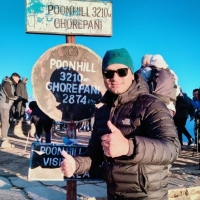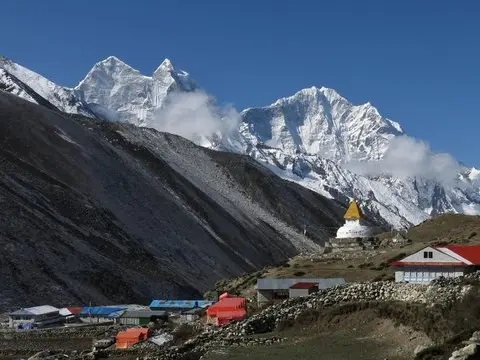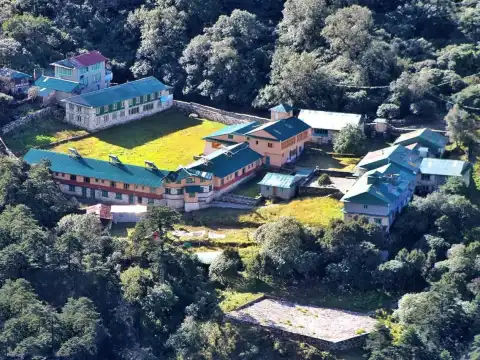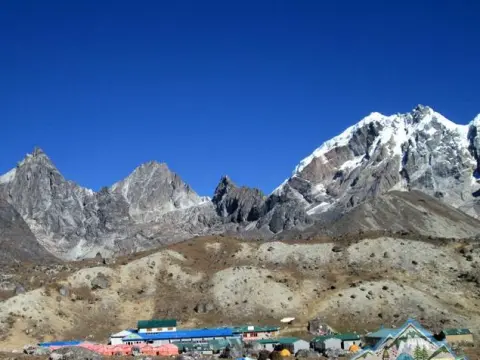Dingboche: Second Acclimatization Stop on EBC Trek
IntroductionDingboche is a beautiful high-altitude village in Nepal's Everest region. It is situated at an elevation of 4,410 m above sea level. The v...


Additionally, Mongla connects significant trails between Tengboche (3,867 m), Phortse (3,810 m), and Pangboche (3,985 m). The village is perched on a beautiful ridge above the confluence of the Dudh Koshi and Imja Khola rivers. Because of this location, Mongla commands superb vistas of Ama Dablam (6,812 m), Thamserku (6,608 m), and Kangtega (6,782 m). The entire landscape is peaceful and pristine.
Similarly, Mongla is less crowded than the well-known villages of Namche or Tengboche. Fewer trekkers visit this area, so it is peaceful and quiet. The natural beauty around Mongla is unspoiled and serene. Trekkers mostly take their lunch or rest here and then move towards Phortse or this, Mongla also plays a key role in acclimatization. Trekkers taking the Phortse loop spend extra nights in the Mongla area to become accustomed to high altitude. This reduces the risk of altitude sickness. Mongla treks are safe, well-marked, and teeming with flora and fauna.
Briefly, Mongla is a hidden gem of the Everest trail from crowds. It offers a more serene experience for visitors. Its scenic beauty, peaceful ambiance, and important trail connections set it apart. Therefore, trekkers who crave peace and beauty always enjoy themselves in Mongla. It is both a picturesque viewpoint and a tactical resting spot.
Mongla is located in the Khumbu region of Nepal, within Sagarmatha National Park. It stands on a ridge at an elevation of about 3,973 meters (13,034 ft). The settlement lies on the Everest Base Camp trek route between Phortse (3,810 m) and Tengboche (3,867 m). This makes Mongla a suitable overnight stop for trekkers.
Additionally, Mongla sits atop the meeting point of two rivers — the Dudh Koshi and Imja Khola. The geography around is hilly and rugged. Pine and rhododendron forests blanket the slopes. The forests burst into vibrant bloom in spring, bringing splashes of color to the landscape.
In the same way, Mongla offers breathtaking panoramas of high Himalayan peaks. Ama Dablam (6,812 meters) stands tall near the village. Trekkers also catch a glimpse of Kangtega (6,782 m) and Thamserku (6,608 m) nearby. These mountains make up a beautiful background throughout the year.
Furthermore, Mongla's ridge-top position exposes it to unpredictable weather. Winds can be strong and temperatures can drop suddenly. Snow is typical during winter months, and paths can be slippery. Spring and autumn offer the best clear skies for viewing the mountains.
Additionally, the Mongla village connects several major trekking routes. One route leads west to Dole and Phortse. Another leads east to Pangboche and Tengboche. Thus, Mongla serves as a crossroads for trekkers using alternate routes.
In short, the geography and situation of Mongla shape its unique character. Its lofty ridge top affords panoramic views of mountains and dense forests. It connects important trekking trails, making it accessible to tourists. Its scenic beauty and strategic positioning make it a place worth visiting along the Everest trek.
Mongla is accessible only by foot. There are no roads or transportation that link this remote village. Trekkers must trek from the nearby villages of Phortse or Tengboche. The trails are clearly marked and well maintained. This makes the journey secure and convenient.
Likewise, Mongla is also on the Everest Base Camp trekking trail. Many trekkers stop by en route to Tengboche or Phortse. It is a standard overnight resting place and acclimatization stop. The village offers a peaceful break from more busy places like Namche Bazaar.
Likewise, the trek from Phortse to Mongla also takes 2 to 3 hours. The trail gently ascends uphill via pine and rhododendron forests. Trekkers are rewarded with scenic mountain views along the way. The trail is more or less moderate, suitable for all trekkers.
Also, trekking from Tengboche to Mongla consumes 3 hours. The trail encompasses some steep sections but can be managed by trekkers who are physically fit. Suspension bridges and river valleys crossing add more adventure to the trek. The weather can become unstable quickly, so trekkers must be well equipped.
Moreover, there is no motorable access to Mongla. Helicopter flights link only major points such as Lukla or Namche Bazaar. This limited accessibility preserves Mongla's peacefulness and traditional character. The village offers an authentic Himalayan experience without tourist crowds.
Lastly, Mongla's accessibility is exclusively trekking-based. The well-defined trails from Phortse and Tengboche connect the village to the Everest region. It is therefore an ideal stopover point for rest and acclimatization. The peaceful atmosphere is a boon to trekkers who make the effort. Mongla remains an undiscovered haven for adventure seekers and trekkers.
Mongla has also offered basic but essential facilities for trekkers. There exist some tea houses and lodges in the village. They give simple rooms with warm blankets and shared bathrooms. Hot showers are offered by some of the lodges in the main trekking seasons. Electricity is supplied mainly through solar power. Power outages do happen from time to time, especially during poor weather.
Besides, there are healthy foods in the tea houses in Mongla apt for high-altitude trekkers. Dal bhat, noodles, and momos are regular dishes. Hot drinks like tea and coffee are everywhere. The dining halls typically have great views of Ama Dablam (6,812 meters) and nearby peaks. This makes resting and recovery comfortable.
Likewise, there are some small shops selling general trekking gear such as snacks, batteries, and souvenirs. The selection is limited due to Mongla's remote location. Visitors are advised to bring necessities from larger villages such as Namche Bazaar or Tengboche. Mobile phone reception is weak, and internet access is limited. This adds to the peaceful charm of the village.
Furthermore, medical facilities are few in Mongla. It lacks any official hospital or clinic. Some guesthouses provide basic first aid and medicines. In case of serious medical conditions, evacuation to Namche Bazaar or Kathmandu is necessary. Helicopter rescue is possible but expensive.
Additionally, there is an issue of waste management in the region. Therefore, the locals and trekking agencies take steps to reduce environmental impact. Trekkers are asked to bring their garbage back and reduce plastic litter. It is important to conserve the fragile mountain ecosystem for sustainable tourism.
In brief, Mongla provides the requisite facilities to host trekkers. Its facilities, though rudimentary, ensure a comfortable and safe stay. The serenity of the village and the basic amenities of the village make it a destination worth visiting. Facilities in Mongla render it a worthy quiet stopping-over destination along the Everest trail.
Mongla offers some unique attractions for trekkers and visitors. The village highlight is the untouched and tranquil Sherpa culture. The traditional stone houses with colorful prayer flags create a scenic atmosphere. Visitors enjoy walking along quiet streets covered with mani walls. These walls made of stone contain inscriptions of holy Buddhist prayers, making the location spiritually significant.
Furthermore, Mongla's location provides breathtaking mountain views. Ama Dablam (6,812 meters) looms over the surroundings with its dramatic snow-capped peak. Trekkers also enjoy nearby peaks such as Kangtega (6,782 m) and Thamserku (6,608 m). These mountains create a breathtaking backdrop that changes with the light and weather. Views from Mongla are consistently considered to be some of the most beautiful on the Everest trek.
Likewise, the Mongla village is near the Tengboche Monastery, one of the largest and most important monasteries in the Khumbu region. Most trekkers use Mongla as a resting stop before or after Tengboche. The monastery holds colorful festivals like Mani Rimdu, which attract pilgrims from all across Nepal and the globe.
In addition, the surrounding rhododendron forests are in full bloom during spring. The forests add patches of red, pink, and white color to the landscape. It houses wildlife such as Himalayan birds and small mammals. Bird watchers will be able to spot birds such as the Himalayan monal and blood pheasant.
Additionally, Mongla's peaceful and scenic trails are an attraction by themselves. Trekkers stroll through meadows and woods at leisure. The village offers a chance to see the pristine beauty of the Himalayas.
In short, Mongla's major attractions are a mix of natural beauty, culture, and spirituality. These make it a memorable place on the Everest trekking route. Visitors leave with long-lasting impressions of Himalayan landscapes and life.
There are trekkers and travelers' activities in Mongla. The most common activity is trekking along the Everest Base Camp trail. Trekkers usually stop at Mongla for rest and acclimatization at 3,973 meters elevation. This is to prevent altitude sickness on the demanding trek ahead.
Moreover, cultural tourism is practiced here in Mongla. Trekkers explore the village's traditional Sherpa culture. They see prayer flags, mani walls, and traditional houses. Many prefer visiting local families and learning about their traditions. This cultural exchange enriches the trekking further.
Likewise, photography is also a popular pastime in Mongla. The village is encircled by fantastic vistas of Ama Dablam (6,812 meters) and neighboring peaks. Sunrise and sunset bring dramatic lighting to the mountains. The colorful prayer flags and stone structures render photographs more inviting. Trekkers capture the harmony of nature and culture.
Besides, nature walks around Mongla attract nature lovers of wildlife. Treks pass through rhododendron forests and alpine meadows. Spring flowers bring colors to the landscape. Birdwatchers can spot Himalayan monal, blood pheasant, and other birds. These walks provide a leisurely break from strenuous trekking.
Others also take Mongla as a destination for day trips. Day trips to nearby villages or the Tengboche Monastery are favored. The monastery contains important Buddhist festivals that travelers enjoy. Traveling to these destinations increases knowledge about the Khumbu culture.
In conclusion, Mongla offers diverse activities that combine adventure and culture. Trekking, cultural visits, photography, nature walks, and side excursions appeal to most visitors. All these combine to make Mongla a good stopping point along the Everest trail. Visitors take back lifelong memories of the Himalayas.
Mongla is renowned for its serene and original mountain experience. Unlike bustling villages such as Namche Bazaar, Mongla is calm and less crowded. This makes it a choice for trekkers who desire isolation and tranquility along the Everest route. The unspoiled natural beauty of the village contributes to its appeal.
Also, Mongla's location midway between Phortse and Tengboche makes it a natural stopover point. Trekkers use it to rest and acclimatize at 3,973 meters above sea level. This helps to reduce the risk of altitude sickness. Being on popular trekking routes contributes to its popularity.
Likewise, stunning mountain views account for Mongla's popularity. Ama Dablam (6,812 meters), Kangtega (6,782 meters), and Thamserku (6,608 meters) tower near the village. The mountains provide spectacular backdrops and photo opportunities. The natural scenery exhilarates trekkers and nature lovers.
In addition, Mongla is culturally rich with its Sherpa people. Tourists get to see traditional stone homes, prayer flags, and mani walls. The Buddhist heritage of the village is apparent and revered. The local hospitality is warm towards visitors, which also enhances the experience.
Besides, Mongla provides essential trekking facilities despite its remote situation. Simple guesthouses and tea houses provide trekkers' needs. Hot food, hot drinks, and a cozy bed make trips comfortable. The village nicely combines tradition and comfort.
Briefly, Mongla is a favorite because of its natural beauty, cultural authenticity, and strategic location. Its peaceful atmosphere and stunning views make it a trekkers' favorite resting place. Peace-loving and culture-loving trekkers never forget Mongla. Therefore, Mongla is one of the most cherished highlights on the Everest trekking trail.
Mongla offers a variety of tea houses and guesthouses to trekkers. These lodges possess cozy and clean rooms. The rooms generally have shared bathrooms, with some having hot showers. The heating is typically by wood stove or gas heater. Electricity is generally provided by solar panels, and the power can be sporadic.
Also, tea houses in Mongla provide traditional Nepali food ideal for high-altitude trekking. Dal bhat, noodles, and momos are popular. Hot tea and coffee are available all day. Dining rooms often enjoy excellent views of Ama Dablam (6,812 meters) and nearby peaks. This comfortable environment enables trekkers to relax after busy days.
Likewise, the cost of accommodation and food in Mongla goes up during peak spring and autumn trekking seasons. Booking in advance is advised for larger groups or holiday periods. Most tea houses accept cash only. Therefore, trekkers need to carry enough Nepali rupees. Mobile phone coverage is weak, and the internet is not easily accessible.
In addition, most of the tea houses in Mongla are family-owned, benefiting local Sherpa communities. Visitors tend to receive warm hospitality and cultural interactions. Accommodating here gives a glimpse into traditional Sherpa mountain life. The experience is made unforgettable by the simplicity and warmth.
Besides, some of the tea houses offer basic services like charging and laundry. There is generally an extra charge to these services. As Mongla is remote, the prices are slightly steeper than large villages. However, the welcoming atmosphere and stunning scenery make it worth it.
All in all, tea houses and lodges in Mongla offer the comfort that trekkers need. Basic but adequate, they serve most needs well. Good food, good shelter, and mountain vistas are a great combination that renders Mongla a well-liked and friendly stop on the Everest trek.


IntroductionDingboche is a beautiful high-altitude village in Nepal's Everest region. It is situated at an elevation of 4,410 m above sea level. The v...

IntroductionDeboche is a quaint village in the Everest region of Nepal. It lies at around 3,700 meters (12,139 feet) elevation. The village lies appro...

IntroductionDzongla is a small mountain village in the Everest region of Nepal. It is located at an elevation of approximately 4,830 meters (15,846 fe...
